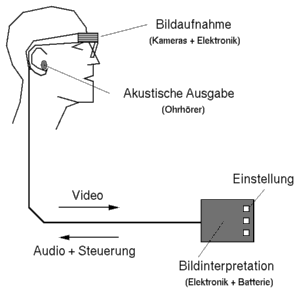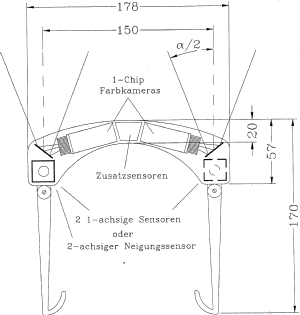Overview

The Name
MOVIS is an acronym for
``Mobil
Optoelectronic
Visual
Interpretative
System
for the blind and visually impaired'' and
for an acronym a surprisingly accurate description of what MOVIS
is and does. It is a portable (i.e. mobil)
system intended as an aid for blind and visually impaired
users. It consists of two cameras on a spectacle-like device,
connected to a computer (i.e. optoelectronic). It works
by interpreting the visual environment and
informing the user about selected objects or classes of objects.
The Explanation
You can think of MOVIS as something
like an electronic guide dog. A dog who can read and who will
talk to you. You can ask it ``Where
is the next zebra-crossing'' (by pressing a button), and it will
look
out for a zebra-crossing and inform you about distance and
direction once it has found one. Or you can ask for the next
bus-stop, mail-box, or public phone. You can even ask it to
read the number of the approaching bus to you, or a
street-sign. Or you can tell it: ``look at this, this is XXXX''
and have it recognise XXXX the next time you pass by.

The Reality
Unfortunately, much of this isn't reality yet. MOVIS, started in
1994, was originally intended as a 9-year project (three 3-year
intervals) funded by the German Ministry
of Science and Technology (BMBF). The aim of the first 3-year
period
(1994-1997) was a laboratory prototype of a
spectacle-like device together with some algorithms which could
be used as a `proof of concept'. The aim of the second 3-year
period were a couple of completely portable prototypes with
enough functionality to be used and evaluated by blind persons
outside the laboratory. The aim of the last 3-year period was
the development of this technology into a product.
Unfortunately funding for all vision-related projects
was cut in 1997, so that very little work is currently done.
What exists are:
- A laboratory hardware prototype.
- Software for the recognition of zebra-crossings
(stable).
- Software for the recognition of public phones and
letter-boxes (working prototype).
- Software for the recognition of selected traffic-signs:
bus-stop, taxi rank, zebra-crossing, public-phone (prototype).
- Software for the recognition of arbitrary views
(prototype).


